Climate change: Have countries kept their promises?
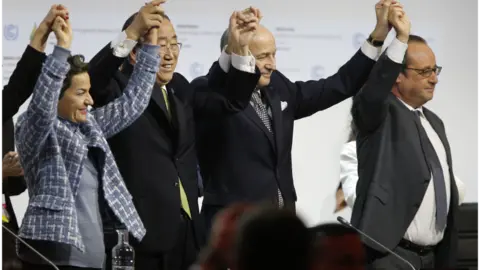 Getty Images
Getty ImagesAgreed by 196 parties in the French capital in December 2015, the Paris climate deal aims to keep the rise in global temperatures this century "well below 2C above pre-industrial levels and pursuing efforts to limit the temperature increase to 1.5C." We look at five key countries and how well they have kept their promises.
Every one of the signatories to the Paris climate agreement has had to lodge a climate action plan with the UN to spell out what steps they are taking to curb carbon.
Overall, according to a new assessment from global consultancy Systemiq, low-carbon solutions have been more successful in this period than many people realise.
The growth in coal for energy outside of China has declined significantly.
"We have to translate what we can do into what we will do," said Lord Nicholas Stern, from the London School of Economics (LSE).
"But a big part of that is understanding what is happening and that's why I think this report is important. It will change people's perspectives of what is possible and translate that into action."
So the big picture might be improving, but what about individual nations? We looked at how five key countries have lived up to their promises under the pact.
The UK
As well as being the world's fifth largest economy, the UK is the incoming president of the Conference of the Parties or COP, the main UN climate negotiating forum, which will take place in Glasgow in November 2021.
This global gathering of world leaders will try and work out how to improve the collective effort to tackle climate change, and take the next steps. COP26 in Glasgow will be the most important meeting since the Paris climate agreement was signed five years ago.
The president of the meeting is a key influence on the success or failure of the event.
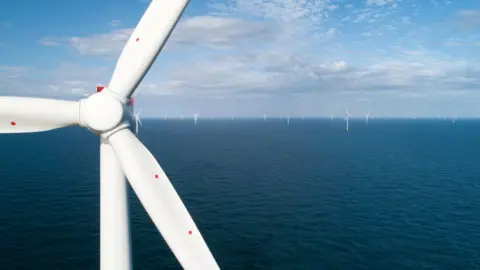 Reuters
ReutersIn Paris in 2015, French foreign minister Laurent Fabius was seen as a hugely effective, impartial leader who gained the trust of nations rich and poor.
UK Business Secretary Alok Sharma has already been tasked with the job by Boris Johnson, but already there are worries that he has too much on his plate.
Has the UK lived up to its promises?
The answer to this is mostly yes.
Since 2008, the UK government has had to set five-year greenhouse gas targets by law, based on advice from the independent Climate Change Committee (CCC).
Targets set under the first three carbon budgets have been met.
While it was part of the EU, the UK's target for 2020 was a reduction of 16% on 2005 emissions.
The UK easily achieved this. In fact, right now, Britain's total output of warming gases has gone down by around 45% from 1990 levels.
As a result of leaving the EU, the UK has to register its own standalone plan to cut carbon with the UN.
This is known as a "nationally determined contribution" or NDC.
It focuses on targets for 2030, which are meant to show the pathway to net zero emissions by 2050.
Reaching net zero requires that any carbon emissions are balanced by absorbing an equivalent amount from the atmosphere by, for example, planting trees.
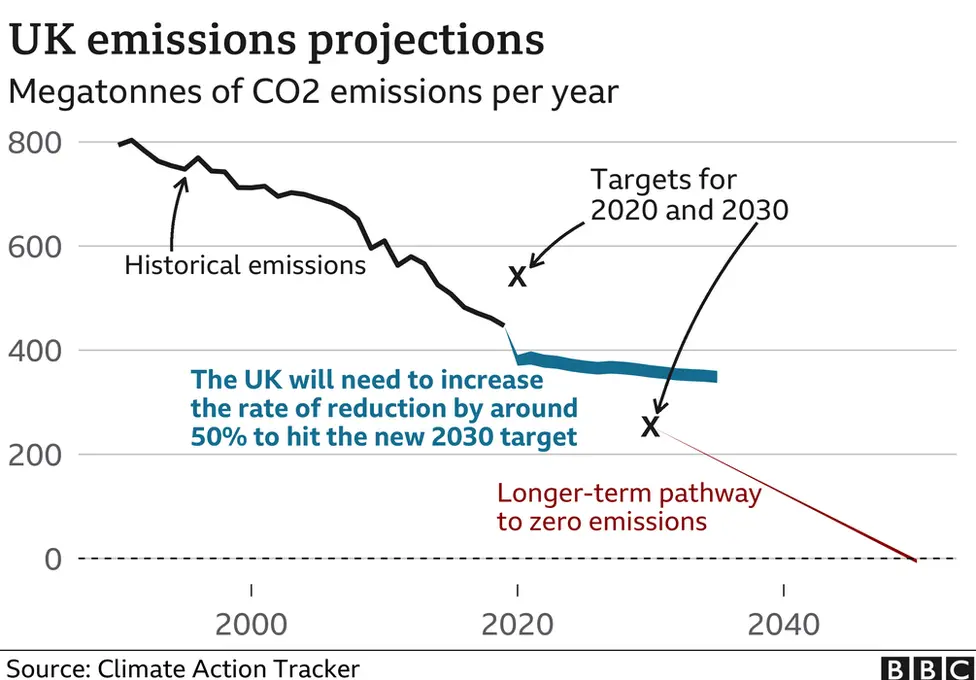
The new 2030 plan, released on 3 December, won plaudits for its ambition. But critics said there were major hurdles ahead.
Under the NDC, around 87% of UK electricity would need to come from low carbon sources by the end of this decade, up from over 50% now.
Almost half the cars on the road would need to be electric, up from around 6% at present.
As well as making major changes to transport, energy and food emissions, the UK will have to take a tough stand internationally so that it doesn't simply substitute carbon cuts at home with emissions-laden products from abroad.
"It's what you do at home, but it's also what you invest in internationally," Dr Alison Doig, from the Energy and Climate Intelligence Unit (ECIU), told BBC News.
"The UK needs to ensure with our export finance credits and with our Brexit deals, that we are strongly signalling overseas, what we're doing domestically."
Nevertheless, in April 2021, the government announced that it would speed up its emissions-cutting plan. Boris Johnson said carbon releases would be reduced by 78% by 2035 - taking the country more than three quarters of the way to net zero.
Australia
Australia matters because not only is it one of the biggest sources of fossil fuels, it is also a country highly vulnerable to the impacts of climate change.
The nation is now the world's largest exporter of coal and gas, according to a recent study.
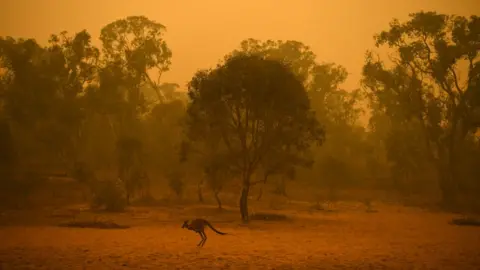 LUKAS COCH
LUKAS COCHEmissions of greenhouse gases from Australian exports are responsible for 3.6% of global emissions according to research.
On a per capita basis, and including exports, Australians are responsible for four times as much CO2 as people living in the US.
Politically, Australia is also very important in climate change terms as well.
Over the past five years, it has moved further away from the majority of nations in the UN, which have been urging rapid cuts in carbon. Prime minister Scott Morrison was criticised by other politicians for downplaying the role of climate change after recent, devastating wildfires.
Has Australia lived up to its promises?
Not really.
While it is set to hit a rather low 2020 target set under a previous global agreement, its actions under the Paris climate agreement are not measuring up, according to experts.
 LUKAS COCH
LUKAS COCHAustralia set a target for 2030 of making a 26-28% reduction in its emissions compared with 2005 levels.
Projections published at the end of 2019 suggested Australian emissions will be only 16% lower than 2005 levels in 2030.
This year's UN Emissions Gap report says that, right now Australia is projected to fall short on what should be a very easy target.
"That 26% reduction needs to be at least double that to be in the Paris Agreement pathway," says Dr Bill Hare, who's part of the Climate Action Tracker group of scientists who have rated Australia's plans as "insufficient".
"There's very little going on whether you're talking about electric vehicles, motor vehicle standards, it's alone in the OECD in not having fuel efficiency standards, it has virtually nothing on energy efficiency, and virtually nothing on building efficiency."
"It is really an embarrassment actually."
There's a lot of focus on Australia now because of changing world politics.
A dispute with China has threatened its exports of coal, while the result of the recent US election has taken away a climate ally of the Australian government.
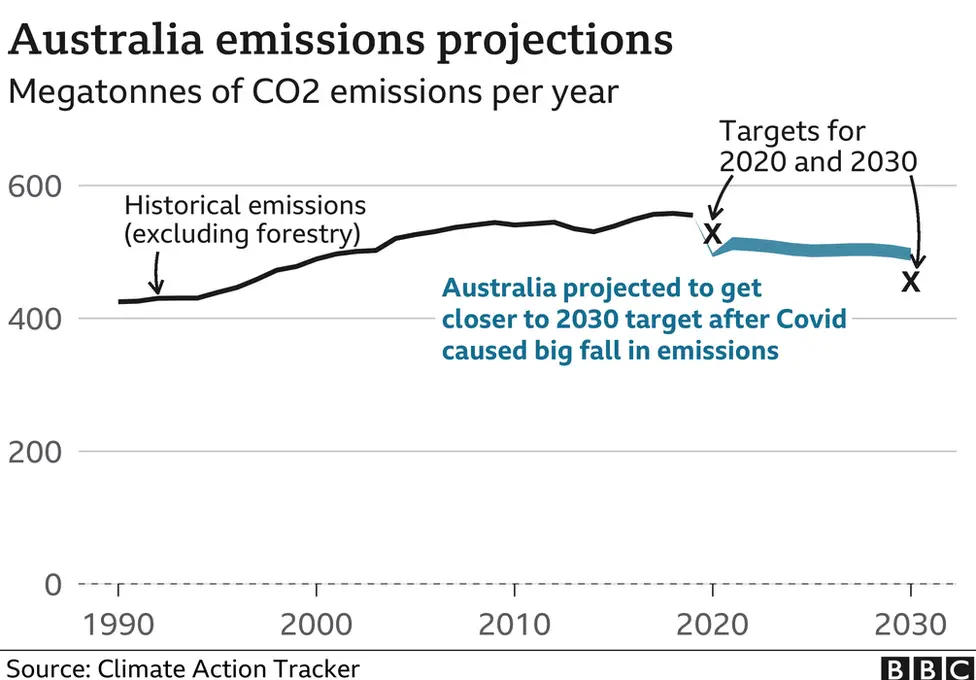
There's even been some talk in recent weeks that the country might soon set a long-term net-zero emissions goal.
And according to newspaper reports, Australia's Prime Minister Scott Morrison is set to announce that the country will no longer use carbon credits carried over from a previous international climate agreement.
Australia had planned to use these questionable credits as a way of making up the shortfall in its 2030 target.
"I think if Trump had won the election then Australia would see themselves as part of a gang with Brazil and Saudi Arabia and a few others," said Dr Alison Doig, from the ECIU.
But with the dawn of the Biden era, "they know are in a position that's becoming more outcast. So that might be why there's some softening on local language and the rhetoric".
While action at the federal level in Australia might be slow, lower down there's a good deal of movement.
"Our energy market operator has said that for the power sector in Australia, we're looking at the fastest transition in the world," said Dr Bill Hare.
"Everyone knows that we're famous for our sunshine, our wind and our space. And that means that renewables are cheap, they are rapidly outcompeting coal and gas, and those technologies are going to be replaced very quickly."
The EU
The EU represents about a fifth of the world's economy - and was responsible for around 9% of the global share of CO2 emissions in 2019, the third largest emitter.
Climate change is seen as a key issue for Europe, because it's an international problem where acting together makes sense to many citizens.
Europe's political leaders also see tackling climate as important in showing the global relevance of the Union.
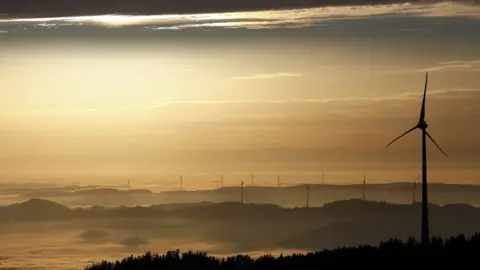 Reuters
ReutersDuring the Trump administration, the EU stepped into a leadership role, attempting to build bridges with China on how to tackle the challenge.
The EU is well-regarded generally among developing countries and small island states because they are seen as wanting to push for greater ambition in terms of cutting carbon.
In terms of building a global alliance of rich and poor countries the EU is key.
Has the EU lived up to its targets?
Mostly, yes.
But back in 2007, EU leaders set a goal of cutting greenhouse gas emissions by 20% of their 1990 levels by 2020.
By 2018, the collective efforts had cut warming gases by 23.2%.
This over-achievement caused many to think that the initial targets had been set far too low.
The EU subsequently announced a target of 40% for 2030, but this too came to be viewed as too easy to meet.
The bloc has now adopted the aim of having a carbon-neutral economy by 2050, in line with the Paris Agreement.
And in the European Green Deal, announced in September 2020, the European Commission proposed a new target for cuts of around 55% by 2030.
In April 2021, ahead of President Biden's climate leaders' summit, the EU adopted the goal.
The European Parliament and many environmentalists had wanted them to go further and aim for a 60% cut.
But the proposal ran into trouble with Eastern European member states who argued this was too much, too soon.
China
China is key to solving the global problem with climate change, because it is the world's biggest contributor to the root cause, CO2 emissions.
As China's economy rapidly expanded over the past two decades, using coal as their main energy source, their emissions have overtaken the US and now comprise around 28% of the global CO2 output.
But China is also the reason for a recent burst of optimism that has spread through the international community since September, when China's President Xi Jinping told the UN that his country would reach carbon neutrality by 2060.
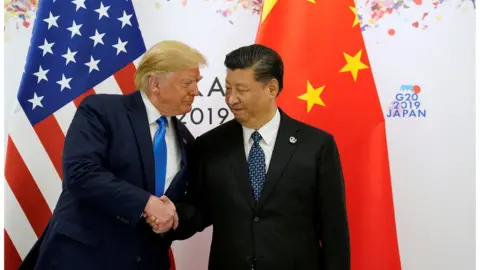 Reuters
ReutersHas China lived up to its promises?
The answer is mostly, yes, but with some caveats.
Seeing itself as a developing country, China has always been reluctant to take on targets to cut carbon, arguing that the West should go first and farthest to rein in CO2.
Instead, China has focussed on carbon intensity rather than cuts. This means limiting the amount of CO2 used per unit of economic activity.
This is easier to achieve than outright emissions reductions but the downside is that as GDP increases so does the overall total of carbon used.
Before the Copenhagen conference of the parties meeting (COP) in 2009, China pledged to cut its carbon intensity by 40-45%, compared to 2005 levels.
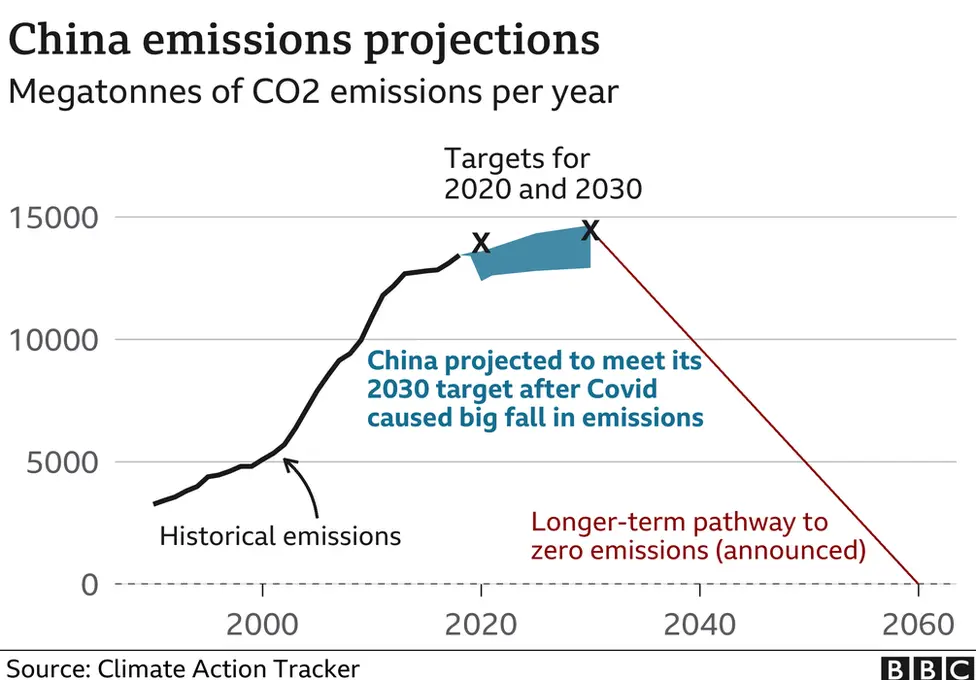
At the end of 2017, China had cut carbon dioxide emissions per unit of GDP by 46% from the 2005 level.
In the Paris Agreement, China promised to cut carbon intensity by 60-65%, and to peak its emissions by 2030.
The country remains on course to meet these goals. In fact, according to some research, it could meet them years ahead of schedule.
"I think China took the conservative approach to the Paris Agreement, they only proposed something that they were very sure that they could meet," says Niklas Höhne from the Climate Action Tracker.
"It was also clear that at, the moment when they proposed their 2030 target, that they would over-achieve it. And that doesn't mean that that it's a bad target, per se, but that's their way of approaching it."
When President Xi Jinping told the UN in September that China would reach net-zero in 2060 and peak its emissions well before 2030, the statement was welcomed all over the world.
But observers said targets contained in the country's five-year plan, released in March 2021, could lead to emissions continuing to increase.
 ALEX PLAVEVSKI
ALEX PLAVEVSKIA new Chinese national commitment is to be submitted to the UN in the run up to the Glasgow COP26 meeting.
But there are significant challenges.
"The nature of the peaking in the 2030 target can be only measured in a 100% certain way after the fact," said Dr Shuwei Zhang, from the Draworld Environment Research Centre in Beijing.
"The 2060 neutrality goal is theoretically possible, but could become unfeasible in reality, if action is continuously delayed."
"From now, there is no leeway to accommodate coal any longer."
 Reuters
ReutersChina will have to limit coal for energy, not just inside the country but outside as well.
The financing of overseas coal power plants will have to wind down.
Right now, the country's emissions have rebounded in the wake of the pandemic, as coal continues to burn brightly.
But many remain optimistic that, if China says it can do something, then it will get there.
The Philippines
The Philippines is one of the countries suffering the most from the impacts of climate change.
 Reuters
ReutersLike many other developing economies, the country is very keen to use energy to bring people out of poverty and raise living standards.
In the past, the Philippines has looked to significantly increase investment in coal to foster development.
But its current approach seeks to move away from coal, and experts say the country could be a role model for many developing nations in similar situations.
Has the Philippines lived up to its promises?
Up until the Paris Agreement, the Philippines had not had any international requirements to curb its carbon.
But in the Paris pact, it committed to cut its emissions by 70% below "business as usual" by 2030. According to the Climate Action Tracker analysis, its actions to date are compatible with keeping warming well below 2C this century.
In 2019, around half the country's electricity came from coal - and plans in the pipeline would have more than doubled the country's coal fired capacity.
But in October 2020, the government announced a moratorium on new coal plants, preferring instead to pursue a more mixed energy strategy.
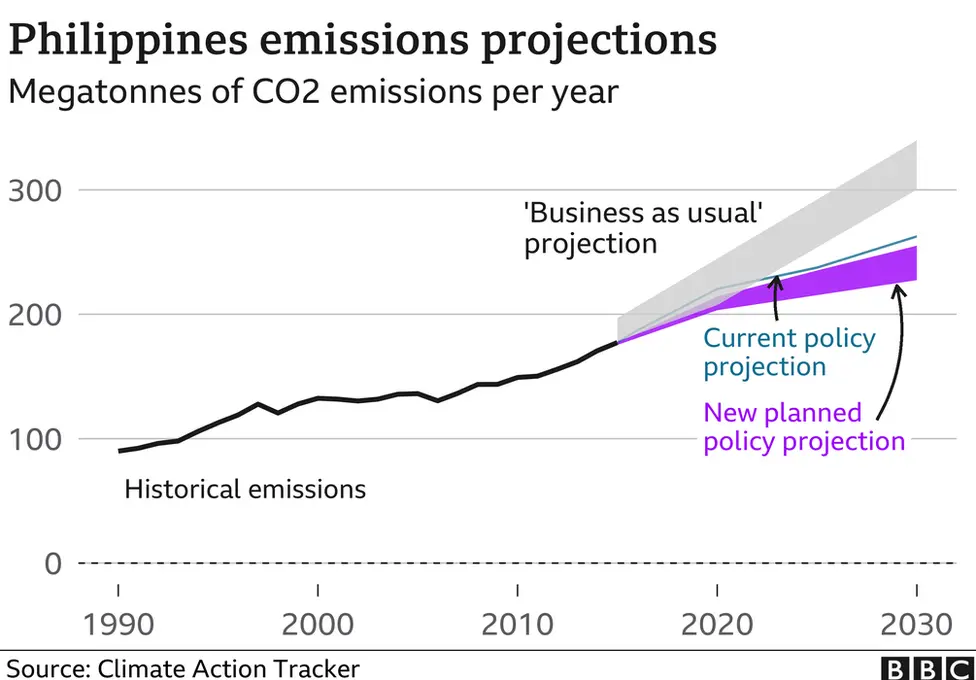
According to the Climate Action Tracker, this could curb emissions from the Philippines by 35% on top of their current policy projections by 2030.
"I think that one of the most critical factors is that the market has been very important in the power sector," said Dr Bill Hare.
"In other countries in Southeast Asia, we have what's called political economy, vested interests dominate in places such as Vietnam or Indonesia."
"But in the Philippines, the market has been really important in determining investments for quite some time. And I think that's what we're seeing unfolding, multiplied by a government predisposition now towards renewables, and a realisation that, as a very vulnerable country, they really need to be getting their act together."
The expectation of observers is that with funding from the UN's Green Climate Fund and more focus on sustainability from international banks, the move away from fossil fuels in the Philippines in the longer term will likely speed up.
The Philippines has not yet set a long-term goal, but it says it is committed to submitting a new national climate plan with enhanced targets.
The country will also likely push for further action on a concept known as "loss and damage" within the UN negotiation process.
For developing nations, this means financial recompense for the impacts of climate change that cannot be avoided or adapted to.
But richer countries are strongly resistant, believing that because they contributed the most to carbon emissions, they will be on the hook for compensation for centuries to come.
Follow Matt on Twitter.
